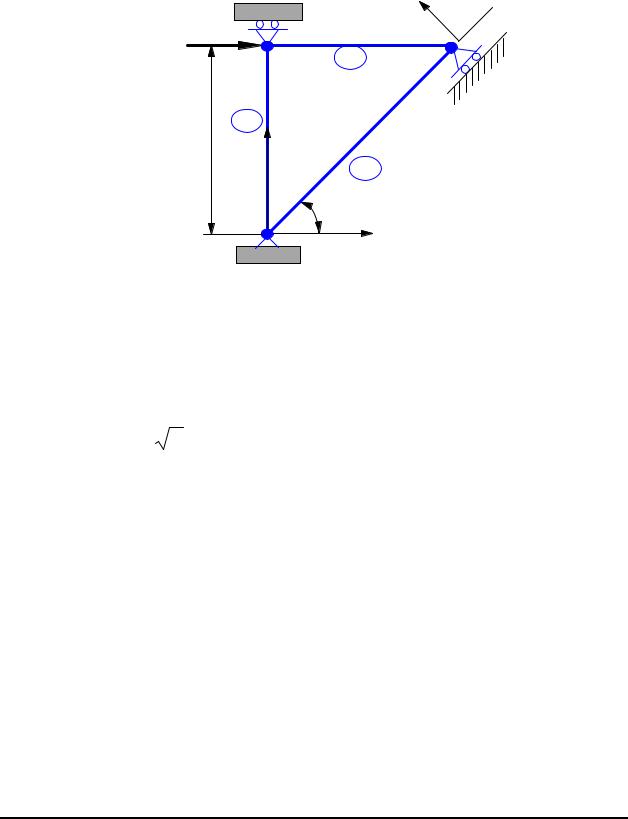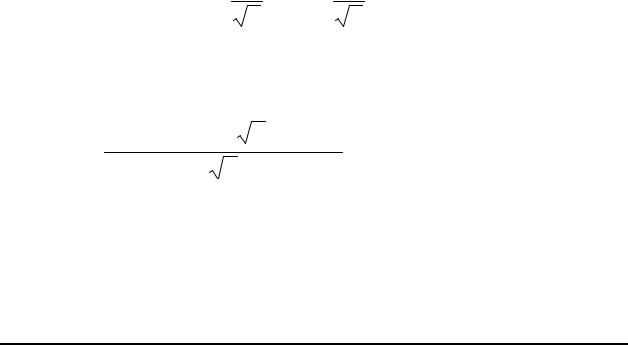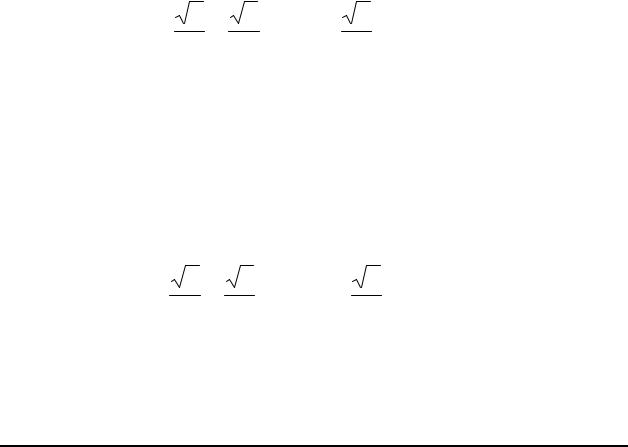
- •Copyright Notice
- •Table of Contents
- •Chapter 1. Introduction
- •I. Basic Concepts
- •Examples:
- •Why Finite Element Method?
- •Applications of FEM in Engineering
- •Examples:
- •A Brief History of the FEM
- •FEM in Structural Analysis (The Procedure)
- •Example:
- •Available Commercial FEM Software Packages
- •Objectives of This FEM Course
- •II. Review of Matrix Algebra
- •Linear System of Algebraic Equations
- •Matrix Addition and Subtraction
- •Scalar Multiplication
- •Matrix Multiplication
- •Transpose of a Matrix
- •Symmetric Matrix
- •Unit (Identity) Matrix
- •Determinant of a Matrix
- •Singular Matrix
- •Matrix Inversion
- •Examples:
- •Solution Techniques for Linear Systems of Equations
- •Positive Definite Matrix
- •Differentiation and Integration of a Matrix
- •Types of Finite Elements
- •III. Spring Element
- •One Spring Element
- •Spring System
- •Checking the Results
- •Notes About the Spring Elements
- •Example 1.1
- •Chapter 2. Bar and Beam Elements
- •I. Linear Static Analysis
- •II. Bar Element
- •Stiffness Matrix --- Direct Method
- •Stiffness Matrix --- A Formal Approach
- •Example 2.1
- •Example 2.2
- •Distributed Load
- •Bar Elements in 2-D and 3-D Space
- •2-D Case
- •Transformation
- •Stiffness Matrix in the 2-D Space
- •Element Stress
- •Example 2.3
- •Example 2.4 (Multipoint Constraint)
- •3-D Case
- •III. Beam Element
- •Simple Plane Beam Element
- •Direct Method
- •Formal Approach
- •3-D Beam Element
- •Example 2.5
- •Equivalent Nodal Loads of Distributed Transverse Load
- •Example 2.6
- •Example 2.7
- •FE Analysis of Frame Structures
- •Example 2.8
- •Chapter 3. Two-Dimensional Problems
- •I. Review of the Basic Theory
- •Plane (2-D) Problems
- •Stress-Strain-Temperature (Constitutive) Relations
- •Strain and Displacement Relations
- •Equilibrium Equations
- •Exact Elasticity Solution
- •Example 3.1
- •II. Finite Elements for 2-D Problems
- •A General Formula for the Stiffness Matrix
- •Constant Strain Triangle (CST or T3)
- •Linear Strain Triangle (LST or T6)
- •Linear Quadrilateral Element (Q4)
- •Quadratic Quadrilateral Element (Q8)
- •Example 3.2
- •Transformation of Loads
- •Stress Calculation
- •I. Symmetry
- •Types of Symmetry:
- •Examples:
- •Applications of the symmetry properties:
- •Examples:
- •Cautions:
- •II. Substructures (Superelements)
- •Physical Meaning:
- •Mathematical Meaning:
- •Advantages of Using Substructures/Superelements:
- •Disadvantages:
- •III. Equation Solving
- •Direct Methods (Gauss Elimination):
- •Iterative Methods:
- •Gauss Elimination - Example:
- •Iterative Method - Example:
- •IV. Nature of Finite Element Solutions
- •Stiffening Effect:
- •V. Numerical Error
- •VI. Convergence of FE Solutions
- •Type of Refinements:
- •Examples:
- •VII. Adaptivity (h-, p-, and hp-Methods)
- •Error Indicators:
- •Examples:
- •Chapter 5. Plate and Shell Elements
- •Applications:
- •Forces and Moments Acting on the Plate:
- •Stresses:
- •Relations Between Forces and Stresses
- •Thin Plate Theory ( Kirchhoff Plate Theory)
- •Examples:
- •Under uniform load q
- •Thick Plate Theory (Mindlin Plate Theory)
- •II. Plate Elements
- •Kirchhoff Plate Elements:
- •Mindlin Plate Elements:
- •Discrete Kirchhoff Element:
- •Test Problem:
- •Mesh
- •III. Shells and Shell Elements
- •Example: A Cylindrical Container.
- •Shell Theory:
- •Shell Elements:
- •Curved shell elements:
- •Test Cases:
- •Chapter 6. Solid Elements for 3-D Problems
- •I. 3-D Elasticity Theory
- •Stress State:
- •Strains:
- •Stress-strain relation:
- •Displacement:
- •Strain-Displacement Relation:
- •Equilibrium Equations:
- •Stress Analysis:
- •II. Finite Element Formulation
- •Displacement Field:
- •Stiffness Matrix:
- •III. Typical 3-D Solid Elements
- •Tetrahedron:
- •Hexahedron (brick):
- •Penta:
- •Element Formulation:
- •Solids of Revolution (Axisymmetric Solids)
- •Axisymmetric Elements
- •Applications
- •Chapter 7. Structural Vibration and Dynamics
- •I. Basic Equations
- •A. Single DOF System
- •B. Multiple DOF System
- •Example
- •II. Free Vibration
- •III. Damping
- •IV. Modal Equations
- •V. Frequency Response Analysis
- •VI. Transient Response Analysis
- •B. Modal Method
- •Cautions in Dynamic Analysis
- •Examples
- •Chapter 8. Thermal Analysis
- •Further Reading

Lecture Notes: Introduction to Finite Element Method |
Chapter 2. Bar and Beam Elements |
Example 2.4 (Multipoint Constraint)
y’
 x’
x’
P |
|
3 |
|
2 |
2 |
L |
1 |
Y |
|
|
3 |
|
1 |
45o |
|
X |
|
|
|
For the plane truss shown above,
P = 1000 kN, L = 1m, E = 210GPa,
A = 6.0 ×10−4 m2 |
for elements 1 and 2, |
A = 6 2 ×10−4 m2 |
for element 3. |
Determine the displacements and reaction forces.
Solution:
We have an inclined roller at node 3, which needs special attention in the FE solution. We first assemble the global FE equation for the truss.
Element 1:
θ = 90o , l = 0, m = 1
© 1997-2002 Yijun Liu, University of Cincinnati |
47 |

Lecture Notes: Introduction to Finite Element Method |
Chapter 2. Bar and Beam Elements |
|
|
|
u1 |
|
|
|
0 |
k1 |
= |
(210 ×109 )(6.0 ×10−4 ) |
0 |
1 |
|
||
|
|
0 |
|
|
|
|
|
|
|
|
0 |
Element 2:
θ = 0o , l = 1, m = 0
|
|
|
u2 |
|
|
|
|
1 |
|
k2 |
= |
(210 ×109 )(6.0 ×10−4 ) |
|
0 |
1 |
|
|
||
|
|
−1 |
||
|
|
|
|
0 |
|
|
|
|
|
Element 3:
θ = 45o , l = 12 , m = 12
|
|
|
|
|
u1 |
|
|
|
|
|
0.5 |
k 3 = (210 ×10 |
9 |
|
|
−4 |
|
|
)(6 |
2 ×10 |
|
) 0.5 |
|
|
|
2 |
|
|
− 0.5 |
|
|
|
|
|
|
|
|
|
|
|
− 0.5 |
v1 |
u2 |
v2 |
|
|
0 |
0 |
0 |
|
|
1 |
0 |
−1 |
(N / m) |
|
0 |
0 |
0 |
|
|
|
|
|||
−1 |
0 |
1 |
|
|
|
|
|||
v2 |
u3 |
v3 |
|
0 |
−1 |
0 |
|
0 |
0 |
0 |
(N / m) |
0 |
1 |
|
|
0 |
|
||
0 |
0 |
|
|
0 |
|
v1 |
u3 |
v3 |
|
0.5 |
− 0.5 |
− 0.5 |
|
0.5 |
− 0.5 |
− 0.5 |
|
− 0.5 |
0.5 |
0.5 |
|
|
|||
− 0.5 |
0.5 |
0.5 |
|
|
|||
(N / m)
© 1997-2002 Yijun Liu, University of Cincinnati |
48 |

Lecture Notes: Introduction to Finite Element Method |
Chapter 2. Bar and Beam Elements |
The global FE equation is,
0.5 0.5 |
0 |
0 |
−0.5 |
||
|
15. |
0 |
−1 |
−0.5 |
|
|
|||||
|
1 |
0 |
−1 |
||
1260 ×105 |
|
||||
|
|
|
1 |
0 |
|
|
|
|
15. |
||
|
|
|
|
||
|
|
|
|
|
|
Sym. |
|
|
|
|
|
Load and boundary conditions (BC):
u1 = v1 = v2 = 0, and v3' = 0,
F2 X = P, F3x' = 0.
−0.5 u1 |
|
F1X |
|||
|
|
|
|
|
|
−0.5 v1 |
|
F1Y |
|||
0 |
u2 |
|
F2 X |
||
0 |
v |
2 |
|
= F |
|
|
|
|
2Y |
||
05. |
|
|
|
|
|
u3 |
|
F3 X |
|||
05. |
v3 |
|
F3Y |
||
From the transformation relation and the BC, we have
' |
|
2 |
2 |
u3 |
|
= |
2 |
(−u3 |
+ v3 ) = 0, |
v3 |
= − |
2 |
2 |
|
|
2 |
|||
|
|
v3 |
|
|
|
|
that is,
u3 −v3 = 0
This is a multipoint constraint (MPC).
Similarly, we have a relation for the force at node 3,
|
2 |
2 |
F3 X |
|
2 |
|
F3x' = |
2 |
2 |
F |
= |
2 |
(F3 X + F3Y ) = 0, |
|
|
|
3Y |
|
|
|
that is,
© 1997-2002 Yijun Liu, University of Cincinnati |
49 |

Lecture Notes: Introduction to Finite Element Method |
Chapter 2. Bar and Beam Elements |
F3 X + F3Y = 0
Applying the load and BC’s in the structure FE equation by ‘deleting’ 1st, 2nd and 4th rows and columns, we have
|
1 |
−1 0 u |
2 |
|
P |
|
|
1260 ×105 |
−1 |
15. |
|
|
|
|
|
0.5 u3 |
|
= F3 X |
|||||
|
0 |
0.5 |
0.5 v |
3 |
|
F |
|
|
|
|
|
|
3Y |
||
Further, from the MPC and the force relation at node 3, the equation becomes,
1 1260 ×105 −1
0
which is
1 1260 ×105 −1
0 The 3rd equation yields,
−1 |
0 u2 |
|
|
P |
|
|
15. |
|
|
|
|
F3 X |
|
0.5 u3 |
|
= |
|
|||
0.5 |
0.5 u |
3 |
|
− F |
|
|
|
|
|
|
3 X |
||
−1 |
|
|
|
|
P |
|
|
2 |
u2 |
|
= |
|
F |
|
|
|
|
|
|
|
|
3 X |
|
1 |
|
|
|
− F |
|
||
u3 |
|
||||||
|
|
|
|
|
|
3 X |
|
F3 X = −1260 ×105 u3
Substituting this into the 2nd equation and rearranging, we have
1260 ×105 |
1 |
−1 u |
2 |
|
P |
|||
−1 |
3 |
|
|
= |
0 |
|
||
|
u3 |
|
|
|||||
Solving this, we obtain the displacements,
© 1997-2002 Yijun Liu, University of Cincinnati |
50 |

Lecture Notes: Introduction to Finite Element Method Chapter 2. Bar and Beam Elements
u2 |
|
|
1 |
3P |
|
0.01191 |
|
||||
|
u |
|
|
= |
|
|
P |
|
= |
|
(m) |
|
2520 ×105 |
||||||||||
|
3 |
|
|
|
|
0.003968 |
|
||||
|
|
|
|
|
|
|
|||||
From the global FE equation, we can calculate the reaction forces,
F1XF1Y
F2Y
F3 X
F
3Y
|
0 |
−0.5 |
−0.5 |
|
−500 |
|
||||
|
|
0 |
−0.5 |
|
|
|
|
−500 |
|
|
|
|
−0.5 u2 |
|
|
|
|||||
= 1260 ×105 0 |
0 |
0 |
|
|
0.0 |
(kN) |
||||
|
u3 |
|
= |
|
||||||
|
|
|
15. |
05. |
|
|
|
|
|
|
|
−1 |
v3 |
|
−500 |
|
|||||
|
|
0 |
05. |
05. |
|
|
|
500 |
|
|
|
|
|
|
|
|
|
||||
Check the results!
A general multipoint constraint (MPC) can be described as,
∑Aj uj = 0
j
where Aj’s are constants and uj’s are nodal displacement components. In the FE software, such as MSC/NASTRAN, users only need to specify this relation to the software. The software will take care of the solution.
Penalty Approach for Handling BC’s and MPC’s
© 1997-2002 Yijun Liu, University of Cincinnati |
51 |
